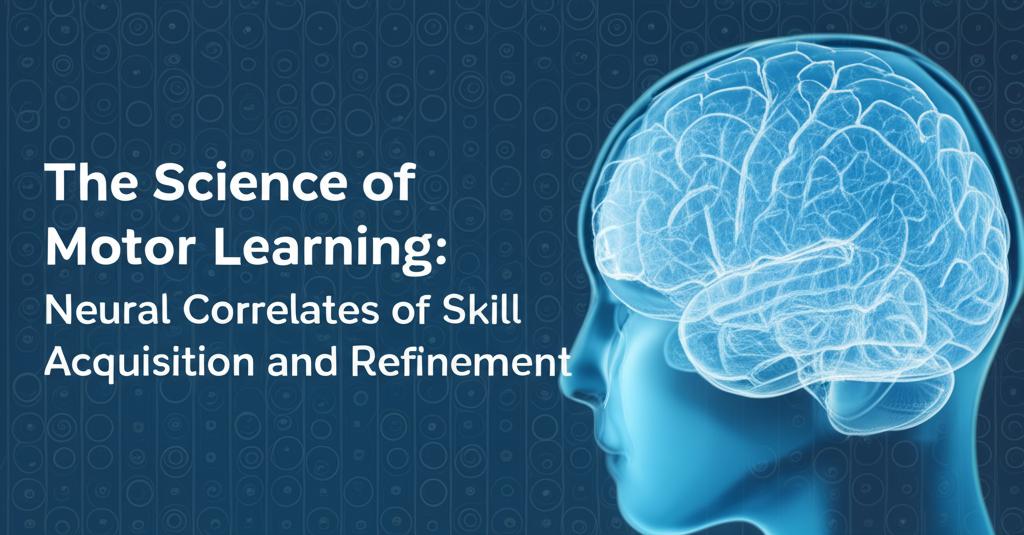Acquiring and refining motor skills is a fundamental process that allows us to interact with and adapt to our environment. This journey from clumsy initial attempts to smooth, expert execution involves a complex interplay of neural mechanisms. Recent advancements in neuroscience, particularly in neuroimaging and non-invasive brain stimulation, have shed considerable light on how our brains change as we learn new movements.
Early Stages of Learning: Laying the FoundationWhen you first learn a new motor skill, such as playing a new musical instrument or mastering a tennis serve, your brain is a hub of widespread activity. Several key brain regions are heavily involved in these initial stages:
- Prefrontal Cortex and Parietal Cortex: These areas are crucial for understanding the task, planning movements, and paying attention. They help in figuring out the spatial coordinates and the "what to do" of the skill.
- Cerebellum: Long known for its role in coordination and balance, the cerebellum is highly active during early motor learning, particularly in sensorimotor adaptation – adjusting movements based on errors and sensory feedback. It's involved in the timing and fine-tuning of movements.
- Basal Ganglia: This group of structures deep within the brain plays a role in selecting and initiating movements, as well as in learning from reinforcement and reward. The striatum, a key part of the basal ganglia, is particularly active.
- Motor Cortex (M1): While M1 is the primary output region for voluntary movements, its activity patterns begin to change even in the early phases of learning.
During this initial acquisition phase, there's often a decrease in the activity of inhibitory neurons in the motor cortex. This reduction in "braking" might create a more permissive environment for neural circuits to change and adapt, a crucial step for learning.
Refinement and Automation: Sculpting the ConnectionsAs practice continues and the skill becomes more refined and automatic, the neural landscape shifts. Key changes include:
- Shifting Reliance: There's often a reduction in the early widespread activation, particularly in prefrontal areas associated with conscious effort. The brain becomes more efficient, focusing activity in specific, relevant circuits.
- Strengthening Pathways: The connections between the thalamus (a sensory and motor relay station) and the motor cortex (the thalamocortical pathway) are physically sculpted and strengthened. This "rewiring" makes the communication between these regions faster, stronger, and more precise, particularly for neurons that encode the learned movements.
- Role of the Cerebellum and Basal Ganglia: The cerebellum remains important for refining the smoothness and accuracy of movements. The basal ganglia, especially the putamen and globus pallidus, become increasingly involved as skills become more habitual and automatic. Different parts of the striatum may be involved at different time scales of learning.
- Motor Cortex Specialization: Within the primary motor cortex (M1), the neural representations of the learned skill become more focused and efficient. Neurons that are critical for the specific learned movements become preferentially activated.
Recent theoretical frameworks suggest motor learning isn't a single, monolithic process but involves several fundamental components:
- Reasoning: Understanding the relationship between actions and their outcomes. This is especially important in the early stages.
- Refinement: Optimizing both sensorimotor and cognitive aspects to achieve movement goals. This involves fine-tuning parameters like force, timing, and coordination.
- Retrieval: Recalling the learned motor patterns efficiently and applying them in the appropriate context, often without conscious thought.
- Time Scale of Practice: The brain areas involved and the nature of their activity change depending on whether learning occurs over a short period (less than an hour), a medium period (a few hours to a day), or a long period (days to weeks). For instance, activity in the striatum may shift from more rostral (front) to more caudal (back) regions as learning progresses from medium to long time scales.
- Task Difficulty: The complexity of the task can influence which neural resources are recruited and how plasticity manifests, especially in different age groups.
- Age: While older adults retain the capacity to learn new motor skills, there can be age-related differences in brain activity patterns and the extent of neural plasticity. For example, older adults might show more bilateral brain activity compared to younger adults for the same task.
- Feedback and Reward: Reinforcement learning, driven by feedback about performance and potential rewards, significantly shapes skill acquisition. The brain's reward circuitry, involving areas like the midbrain and striatum, plays a crucial role in this process.
Underlying all these changes is neuroplasticity – the brain's remarkable ability to reorganize its structure and function in response to experience. Learning new motor skills leads to:
- Functional Reorganization: Changes in the activation patterns and connectivity between brain regions.
- Structural Changes: Evidence suggests that motor learning can even lead to changes in gray matter volume or density in brain areas associated with the learned skill, although some of these changes might be reversible if practice stops.
Understanding the neural correlates of motor learning has significant implications. It can inform the development of more effective rehabilitation strategies for individuals recovering from stroke or other neurological injuries that impair motor function. Furthermore, this knowledge can be applied to optimize training programs in sports, music, and other fields where skilled movement is paramount.
Ongoing research continues to unravel the intricate details of how different brain regions interact, how various neural oscillations (like beta waves) contribute to learning, and how individual differences in brain structure and function might predict learning capabilities. The emerging picture is one of a highly dynamic and adaptable brain that continuously refines its internal wiring to master the art of movement.

